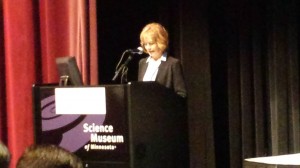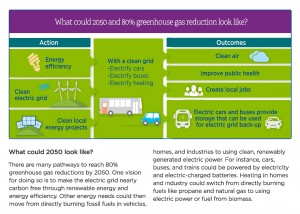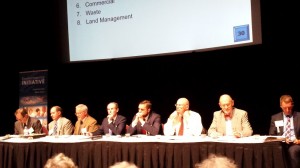Minnesota’s New Climate Action Plan

Learn how our State can achieve it’s goal to reduce CO2 by 80% while strengthening our Economy.
Here are our notes from the July 20, 2016 launch of the MN EQB’s Climate Solutions and Economic Opportunities action plan with key initiatives from all state agencies and how your community can do its part to achieve these goals and benefits.
Key Themes from the MN State Climate Action Plan:
- Expand clean energy on our electric grid – explore how to increase the MN Renewable Energy Standard from 25% to 50%
- Deepen participation in our CIP energy efficiency programs, and increase annual energy savings from 1.5% to 2.5%
- Ensure that new commercial and residential buildings meet the standards that new state buildings will be achieving through the SB 2030 Building Energy Standards
- Expand investment in transit and transit oriented development
- Electrify transportation, heating, and cooling to meet our 2050 CO2 reduction goals
Hosted by the Environmental Initiative, Wednesday, July 20, 2016 at the Science Museum of Minnesota
Blog Post by Sean Gosiewski, Executive Director, Alliance for Sustainability
Resources
- July 20 Event Page
- Download the report: “Climate Solutions and Economic Opportunities – A Foundation for Minnesota’s State Climate Action Planning”
- MPR Story: “Minnesota must do more to cut greenhouse gas linked to climate change” by Elizabeth Dunbar, July 21, 2016
- Alliance Blog Link
- Sustainable Communities Events: Planning for Resilient Cities Metro Wide Workshop (Oct 2016) and Resilient Cities Cluster Meetings (Jan 2017)
Presentation Highlights
Overview
The Climate Subcommittee of the Minnesota Environmental Quality Board (EQB) is leading a project to evaluate a variety of strategies for their potential to grow our economy and reduce greenhouse gases that contribute to climate change, an initiative known as Climate Solutions and Economic Opportunities (CSEO).
The goal of the project was to provide multiple opportunities for stakeholders to share ideas, information, and perspectives that will help to inform decisions about potential near-term (2015 – 2030) actions to reduce greenhouse gas emissions. Environmental Initiative worked on behalf of the Subcommittee to engage stakeholders in this effort. A series of large informational events and smaller working sessions were held between November 2014 and February 2015.
 Lieutenant Governor Tina Smith:
Lieutenant Governor Tina Smith:
- Increase our MN Renewable Energy Standard from 25% to 50%
- Retire coal plants while supporting dislocated workers, especially in Becker
- Increase annual energy savings from 1.5% to 2.5%
- Ensure new government, commercial and residential buildings will meet SB 2030 Building Energy Standards
- Build a diverse coalition to get this done
- Now establishing in the Dept. of Administration the new Office of Enterprise Wide Sustainability
 Economic Benefits: Neal Young, Minnesota Department of Employment and Economic Development
Economic Benefits: Neal Young, Minnesota Department of Employment and Economic Development
- The State and the Center for Climate Strategies used the well regarded REMI model to study to future economic impacts of MN implementing strategies to achieve State Climate Reduction Goals. CSEO Policy Option Documentation
- Most of the policy options are cost negative – including investing in renewable energy and energy efficiency
- Investing in efficiency and renewable energy will also create new jobs
Additional Information
DEED report on the Clean Energy Economy – the renewable energy sector currently employs over 15,000 Minnesotans
Immediate Impact Policies – Achieving our MN 2030 CO2 reduction goals – Jessica Burdette (State Energy Office, Minnesota Department of Commerce CIP Supervisor):
We are not yet on track to achieve our 2030 CO2 reduction goals, how do we get there?
- Increasing the MN renewable energy standard to 50% = 27% of needed CO2 reductions
- Retiring additional coal plants = 13% of needed CO2 reductions
- Increasing the MN Energy Efficiency standards to 2.5% = 10% of needed CO2 reductions
- Combined heat and power = 10% of needed CO2 reductions
- Implementing SB 2030 with public, private and residential buildings = 14% of needed CO2 reductions
- Waste water energy efficiency
- Waste heat recovery
- Electric vehicles
- Achieving our State 2030 CO2 reduction goals will spur job growth in MN
- We will achieve great cost savings by increasing the renewable energy standard, expanding CIP, CHP and SB 2030
Long Term Strategies to Start Now – Achieving our State’s long term 2050 CO2 reduction goals – Philip Schaffner (MN DOT, Policy Planning Director, Office of Transportation System Management):
- Much of our State’s infrastructure that will be here in 2050 has already been built – buildings, roads, bridges
- We need to start investments now to achieve our 2050 CO2 reduction goals – investments in transit, multi modal transportation, compact development, electric vehicles, urban forests
- Much of our CO2 foot print is from the Transportation Sector
- CO2 in transportation = Distance traveled x energy per distance x GHG per energy unit
- Our vehicle miles traveled is beginning to increase again, as well as population growth
- We can reduce CO2 emissions in transportation by
- Transit investment, creating a good market place for compact development, with easy access to walking, biking and transit
- Electric vehicles – buses, cars, light and medium duty vehicles (not heavy duty vehicles)
- Autonomous vehicles/electric vehicles will be more widespread in MN in 10 years
Pilot Projects to Develop – Anna Henderson (Planning Director – Energy and Environment Policy, MN EQB):
- Transportation – Advanced biofuels, pay-as-you-go car insurance, price on carbon
- Energy – renewable energy, thermal energy
- Agriculture – developing markets for cover crops and perennials, re-forestation
 Highlights from EQB Member Commissioner Comments
Highlights from EQB Member Commissioner Comments
Commissioner Matt Massman, Department of Administration:
- Big impacts through our purchasing policies and by implementing building efficiency, SB 2030
- Great example – MN Capitol Complex renovation – achieving high levels of energy efficiency
- Dept. of Administration is home to the new Office of Enterprise Wide Sustainability
- SB 2030 Building Energy Standards
Commissioner David Frederickson, Department of Agriculture:
- Improving water quality through voluntary programs with farmers, these could be extended to CO2 sequestration
- Minnesota Agricultural Water Quality Certification Program
Commissioner Mike Rothman, Department of Commerce:
- Renewable energy and energy efficiency investments save our state money while growing good jobs
- Increasing the MN renewable energy standard to 50%
- Retiring additional coal plants
- Increasing the MN Energy Efficiency standards to 2.5%
Commissioner Charlie Zelle, Department of Transportation:
- MN DOT is a multi-modal agency – roads, trains, transit, biking, walking
- MN DOT vision: Minnesota’s multimodal transportation system maximizes the health of people, the environment and our economy.
- Secure comprehensive transportation funding that includes all modes
- MN DOT vision, mission, goals
Commissioner John Linc Stine, Minnesota Pollution Control Agency:
- MPCA is tracking MN progress on achieving carbon reductions
- We need to reduce racial disparities of environmental impacts that have serious health consequences
- Annual CO2 reduction report
- Environmental Justice
Commissioner Dr. Edward Ehlinger, Department of Health:
- Environmental factors impact health, even more than health care access
- Reduce environmental impacts on communities of color
- Let’s strengthen equity and social cohesion in Minnesota overall, reducing gun violence and boosting economic opportunities for all
- Advancing Health Equity report
Commissioner Thomas Landwehr, Department of Natural Resources:
- Forests and prairies are vital for CO2 sequestration in MN
- Our forests and prairies have historically sequestered a lot of carbon, we can expand healthy forests and prairies to achieve these benefits
- DNR is working on climate adaptation with communities
- DNR is also working with cities on water supply planning
- Report on the potential for CO2 sequestration in MN
Chair Adam Duininck, Metropolitan Council:
- The Met Council takes the long view
- Transit investment is key to economic growth, serving our growing population and achieving our climate goals
- Supporting cities to develop their own plans and visions, through comprehensive plan updates, including resilience
- Thrive MSP 2040 vision and plan
- Local Planning Handbook
- Resilience
Commissioner Shawntera Hardy, Department of Employment and Economic Development:
- Growing energy efficiency and renewable energy will expand good jobs in MN
- We need to bring jobs to every corner of the state and in communities with racial disparities
- Minnesota’s Clean Energy Economy/MN DEED Report
- Racial Disparities in Employment Outcomes After College
Welcome and Introduction to the CSEO report by Lieutenant Governor Tina Smith
Minnesota has made significant strides to address climate change. Renewable energy now accounts for 21% of the Minnesota’s in-state electricity generation, up from 4% in 2000. Wind energy alone provides over 17% of our state’s electricity – equal to the total electricity use in one in six homes, businesses, and community institutions.
Despite this progress, we missed our 2015 greenhouse gas emission targets and will miss the 2025 goal without additional work. Minnesota needs bold action to meet these goals and secure the environmental, health, and economic benefits of tackling climate change . This report provides the foundation for state climate planning. We need to work together to transform plans into actions.
The need for action is clear: Minnesota is already feeling the impacts of climate change. We have experienced four 1,000-year rainfalls since 2002.
We have watched our spruce, fir, aspen, and birch forests retreat northward. And air pollution related to greenhouse gas emissions annually cost us more than $800 million in increased health care costs.
Addressing climate change also has the potential to grow our economy. By aggressively investing in climate policies, Minnesota could add 25,000 new jobs and generate more than $2 billion in additional wages during the next 15 years.
To achieve these results, Minnesota needs clean energy policies that have an immediate impact on reducing emissions from our homes, buildings, and industries. We also need long-term strategies to transform our communities and their transportation systems to reduce our use of gasoline.
We also must protect and increase the carbon stored in our wetlands, forests, and agricultural lands. These actions will not only help us address climate change, but will also support habitat and water quality, benefiting public health and wildlife. Working together, we can take steps that protect the environment, improve our health, and grow our economy.
Fall 2016 – Resilient Cities Clusters
In October of 2016, the Alliance for Sustainability will work closely with the MN EQB, county and nonprofit resource partners, watershed districts, and utilities to support Resilient Cities Clusters of 5 or more cities in Anoka, Dakota, Hennepin, Ramsey & Washington County. City staff & commission volunteers will meet at an October launch with EQB staff and, in January, will share their draft Comprehensive Plans.
Find practical resources for your city to include resilience themes into your Comprehensive Plan, including:
- Mitigation – Conserving energy and moving toward renewable energy
- Adaptation – Helping your city infrastructure and residents be ready for extreme weather
- Health/Equity/Economy – improving the health & economic status of diverse and/or vulnerable citizens including active living and healthy food access strategies
Meet with your peers from other cities within your county and with technical resource experts to:
- Share and compare plan language, goals and strategies
- Connect with resources to map existing conditions, energy usage, climate vulnerabilities, etc.
Learn from cities that have developed action plans & implementation strategies through Xcel’s Partners in Energy, LoGoPep, the Mayors Compact, or MN GreenSteps to help meet our MN CO2 reduction goals!
Participating Cities – Spring 2016 Planning for Resilient Cities Workshops:
This spring 350 city staff, elected leaders, commission and community volunteers from 73 cities and townships joined us to find practical resources to include energy, resilience, active living, healthy food access and equity in their comprehensive plans.
Anoka County Workshop – Tues January 26, Coon Rapids Civic Center: (14 cities) from Anoka, Andover Blaine, Coon Rapids, Fridley, Linwood, Lexington, Osseo, Now Then, St. Francis, Anoka County, Brooklyn Park, St. Louis Park.
Dakota County Workshop – Thurs June 2, Apple Valley Senior Center: (12 cities) Apple Valley, Burnsville, Eagan, Inver Grove Heights, Hastings, Mendota Heights, Rosemount, South St. Paul, Savage, Sunfish Lake, West St. Paul and Faribault.
Hennepin County Workshop – Wed March 23, Minnetonka Community Center: (19 cities) Bloomington, Brooklyn Center, Brooklyn Park, Columbia Heights, Crystal, Dayton, Edina, Golden Valley, Greenfield, Hennepin County, Minneapolis, Hopkins, Medicine Lake, Minnetonka, Osseo, Richfield , Robbinsdale, Shorewood, St. Louis Park, Wayzata.
Ramsey County Workshop – Mon March 28, Ramsey Co Public Works: (14 cities) Arden Hills, Rice Creek Commons, Falcon Heights, Lauderdale, Little Canada, Maplewood, Mounds View, New Brighton, North St. Paul, Ramsey County, Roseville, Shoreview, St. Paul, Vadnais Heights, White Bear Lake, White Bear Township.
Washington County Workshop – Tues March 29, Stillwater Library: (14 cities and townships) Afton, Bayport, Bay Township, Cottage Grove, Forest Lake, Lake Elmo, Mahtomedi, Marine, Oak Park Heights, Oakdale, Scandia, Washington County Public Health, Stillwater, Stillwater Twp, Woodbury Comp Plan Task Force.
With support from the Bush, Headwaters & McKnight Foundations, watershed districts, counties and MPCA.
To learn more please visit www.allianceforsustainability.com/sustainablecommunities or contact Sean Gosiewski, Executive Director, Alliance for Sustainability, 612-250-0389 sean@afors.org.


